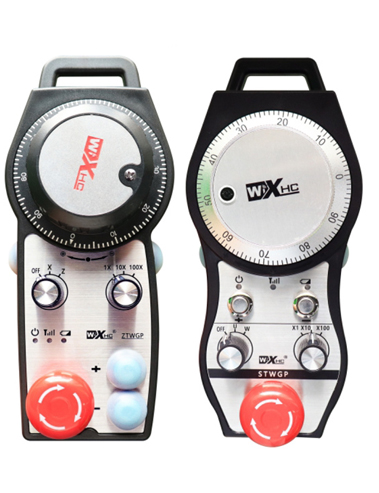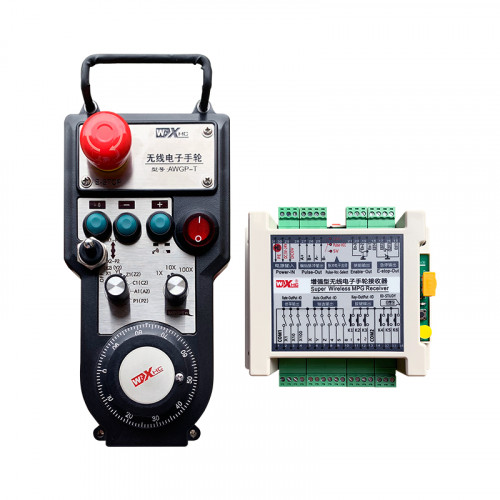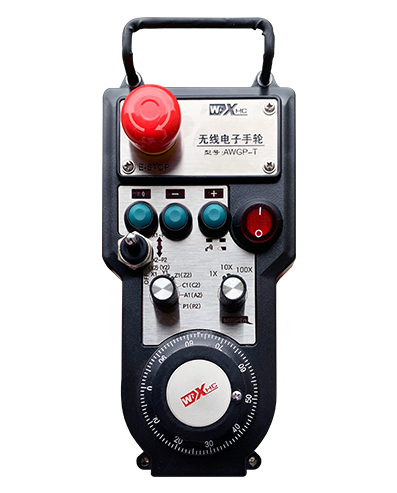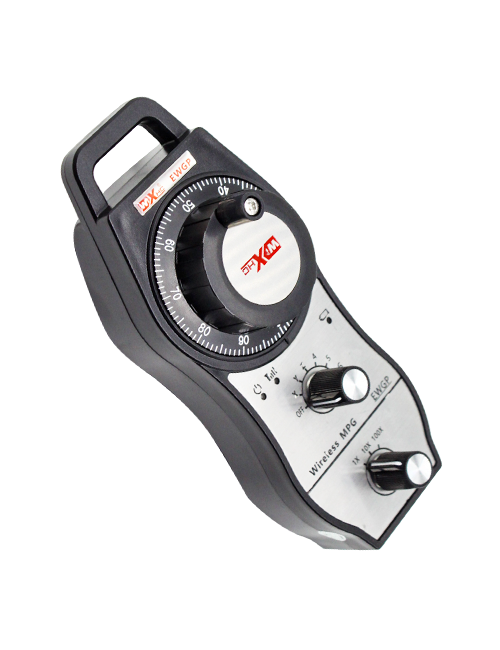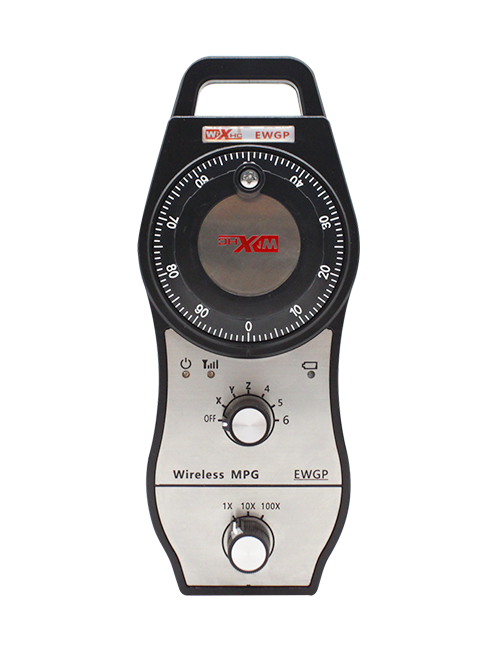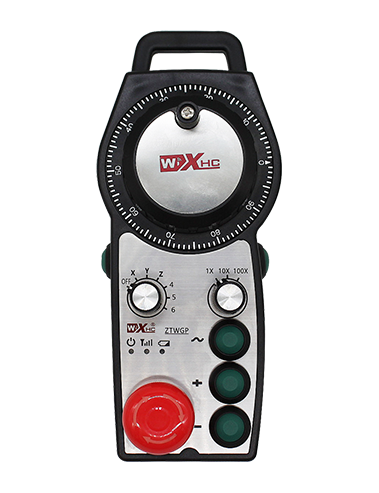Hole le mohala o se nang mohala oa cnc e otlolohileng bakeng sa litaelo tsa ts'ebetso
Tlhaloso

1.Selelekela sa Product
2. Product functional features
| Operating voltage and current of wireless remote |
3V/14MA
|
| Battery specifications | 2 AA alkaline batteries, size 5 |
| Low voltage alarm range of wireless remote | < 2.3V |
| Receiver power supply voltage | DC5V-24V/A |
| Receiver emergency stop output load range | AC125V-1A/DC30V-2A |
| Receiver enable output load range |
AC125V-1A/DC30V-2A
|
| Receiver custom button output load range | DC24V/50mA |
| Receiver axis selection output load range | DC24V/50mA |
| Receiver magnification output load range | DC24V/50mA |
| Transmission power of handheld terminal |
15dBm
|
| Receiver receiving sensitivity | -100dBm |
| Wireless communication frequency | 433MHz frequency band |
| Wireless communication distance | Barrier free distance of 40 Metres |
| Operation temperature | -25℃ < X < 55℃ |
| Anti fall height | 1 (Meter) |
| Custom button quantity | 2 |


Lintlha:
① Pulse encoder:
Tobetsa le ho ts'oara konopo ea ho nolofalletsa, shake the pulse encoder, emit a pulse signal,and control the movement ofthe machine axis.
② Enable button:
Press either enable button on either side, and the two sets of enable IO outputs on the receiver will conduct. Release the enable button to disconnect the enable IO output; And before switching the axis selection magnification and shaking the handwheel,the enable button needs to be held down to be effective; This function can be cancelled through configuration software.
③ Indicator lights:
Left side light: power on light,the handwheel uses the axis to select OFF for power on, and this light stays on after power on;
Middle light: a signal light that lights up when operating any function ofthe handwheel, and does not light up when there is no operation;
Right side light: Boholo ba alamo ea voltage, low battery level,this lightflashes or stays on, battery needs to be replaced.
④ Emergency stop button:
Tobetsa konopo ea STRED STORE, and the two sets of emergency stop IO outputs on the receiver will be disconnected, and all functions of the handwheel will be invalid.
⑤ Magnification switch:
Press and hold the enable button to switch the magnification switch, which can switch the magnification controlled by the handwheel.
⑥ Axis selection switch (Phetoho ea Matla):
Press and hold the enable button to switch the axis selection switch, which can switch the movement axis controlled by the handwheel. Switch this switch from OFF to any axis and turn on the handwheel power.
⑦ Custom button:
Two custom buttons, each corresponding to an IO output point on the receiver.

6.1 Product installation steps
1. Install the receiver into the electrical cabinet through the buckle on the back, or install it into the cabinet through the screw holes at the four corners of the receiver.
2. Refer to our receiver wiring diagram and compare it with your on-site equipment. Connect the equipment to the receiver via cables.
3.After the receiver is properly fixed, Antena e nang le moamoheli e lokela ho hokahanngoa, and the outer end of the antenna should be installed or placed outside the electrical cabinet. Ho khothalletsoa ho e beha kaholimo ho cabinet ea motlakase bakeng sa phello e ntle ka ho fetisisa. It is prohibited to leave the antenna unconnected or place it inside the electrical cabinet, as this may result in the signal being unusable.
4. Qetellong, turn on the power switch of the handwheel, and you can operate the machine remotely using the handwheel.
6.2 Tekanyo ea moamoheli

6.3 Ramoa

7. Litaelo tsa ts'ebetso ea sehlahisoa
1. Power on the machine and the receiver. The receiver’s working indicator light flashes. Install the battery in the wireless electronic handwheel, secure the battery cover, mme
turn on the power switch of the wireless electronic handwheel. The handwheel’s battery level indicator light is on.
2. Kgetha Axis: Tobetsa le ho ts'oara konopo ea ho nolofalletsa, toggle the axis selection switch, and select the axis you want to operate.
3. Khetha Bonolo: Tobetsa le ho ts'oara konopo ea ho nolofalletsa, toggle the magnification switch,and select the desired magnification level.
4. Ho tsamaisa Axis: Tobetsa le ho ts'oara konopo ea ho nolofalletsa, Khetha phetoho ea axis, select the magnification switch, and then rotate the pulse encoder. Rotate clockwise to move the
positive axis and counterclockwise to move the negative axis.
5. Tobetsa le ho tšoara konopo ea tloaelo, and the corresponding button IO output of the receiver will be turned on. Release the button, and the output will be turned off.
6. Tobetsa konopo ea STRED STORE, the corresponding emergency stop IO output of the receiver will be disconnected, the handwheel function will be disabled,release the emergency stop button, the emergency stop IO output will be closed, and the handwheel function will be restored.
7. Haeba maqhubu a letsoho ha a sebetse nako e telele, it will automatically enter sleep mode to reduce power consumption. Ha e sebelisoa hape, the handwheel can be activated by pressing the enable button.
8. Haeba li-handheel ha li sebelisoe nako e telele, it is recommended to switch the handwheel shaft to the OFF position, tima matla a matsoho, ebe o holisa bophelo ba betri.
8. Tlhaloso ea mohlala oa sehlahisoa

① :ZTWGP represents the appearance style
②:Ho pullisa litekanyetso:
01: Indicates that the pulse output signal is A, B; Volse voltage 5v; pulse quantity 100PPR.
02:Indicating thatthe pulse output signals are A and B; Pulse voltage 12V; pulse quantity 100PPR.
03:Indicating thatthe pulse output signals are A, B, A -, B -; Volse voltage 5v; pulse quantity 100PPR.
04:E supa tlhahiso e tlase ea potoloho e bulehileng, ka lipontšo tsa ho hlahisoa ha ho hlahisoa ha li-le b;The number of pulses is 100PPR.
05:E bonts'a tlhahiso e phahameng ea Pnp PRNP, ka lipontšo tsa ho hlahisoa ha ho hlahisoa ha li-le b; The number of pulses is 100PPR.
③:Representing the number of axis selection switches, 2 e emela 2 axes.
④:Represents the type of axis selection switch signal, E emela lets'oao la ho kenya lintlha, and B represents encoded output signal.
⑤:Represents the type of multiplication switch signal, E emela lets'oao la ho kenya lintlha, and B represents encoded output signal.
⑥:Represents the number of custom buttons, 2 e emela 2 likonopo tsa moetlo.
⑦:Represents the power supply for the system handwheel, mme 05 e emela phepelo ea matla a 5V.
⑧:L represents the left column (left knife holder), and R represents the right column (right knife holder).
9.Solution to Product Malfunctions

1. Ka kopo e sebelise tikolohong e omeletseng ka mocheso oa kamore le khatello ea ho eketsa bophelo ba bona.
2. Ka kopo qoba ho sebelisa tikolohong e sa tloaelehang joalo ka ha pula le likhoho tsa metsi li ka eketsa bophelo ba tšebeletso.
3. Ka kopo boloka ponahalo ea makhasi a bonoa a hloekisitse bophelo ba bona.
4. Ka kopo qoba ho teba, ho oela, ho thothomela, etc. to prevent damage to the precision components inside the handwheel or accuracy errors.
5. Haeba e sa sebelisoe nako e telele, Ka kopo boloka letsoho la letsoho le le leng sebakeng se hloekileng le se sireletsehileng. Nakong ea polokelo le lipalangoang, Tlhokomeliso e lokela ho lefuoa ho mongobo le ho tšoha.
11. Tlhahisoleseling ea polokeho
1. Ka kopo bala litaelo ka hloko pele li sebelisoa le ho thibela litsebi tse sa sebetseng.
2. Please replace the battery in a timely manner when the battery level is too low to avoid errors caused by insufficient battery power and inability to operate the handwheel.
3. Haeba ho lokisoa ho hlokahala, Ka kopo ikopanye le moetsi. Haeba tšenyo e bakoa ke ho lokisa, Moetsi a ke ke a fana ka waranti
